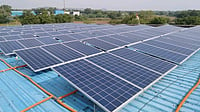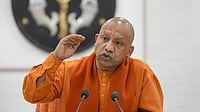Integrating more renewable energy in the power system is crucial for India to meet climate goals, the Institute for Energy Economics and Financial Analysis (IEEFA) said.
In its latest report, IEEFA has also suggested various measures to ramp up the share of clean energy in the country's power system.
To cut emissions, India needs to increase renewable energy integration/absorption, the report said.
"While India has been adding renewable energy capacity at a fast pace to meet its emissions intensity reduction target for 2030, the country needs to ramp up the share of clean energy in its power system. Integrating more renewable energy in the power system is crucial for India to meet climate goals," it noted.
For India to meet growing electricity demand while addressing climate concerns, increased integration of clean energy, including variable renewable energy, is essential, IEEFA Energy Analyst and the report's author Charith Konda said.
While raising non-fossil fuel power installed capacity share to 50 per cent by 2030 may be relatively easier to achieve, reducing the emissions intensity of its economy by 45 per cent by 2030 from 2005 levels requires increased integration of variable renewable energy in the power system, Konda added.
Introducing effective time-of-use (ToU) electricity tariffs will change consumption patterns to suit more renewable energy integration and lower grid balancing requirement, Konda said.
The report also notes that the central government has started to take some demand-side measures by recently issuing guidelines for a range of tariff variations.
"Still, India needs dynamic ToU tariffs rather than static ones. Studies suggest that successfully implementing a dynamic ToU pricing regime can reduce peak demand by 5-25 per cent," Konda said.
The report also said that a well-connected national grid ensures optimal utilisation of uneven distribution of energy sources. A strong inter-regional grid will better absorb and balance regional variations in renewable energy generation and reduce renewable energy curtailment.
Regarding energy storage solutions, the report finds that Pumped Hydro Storage (PHS) projects and Battery Energy Storage Systems (BESS) are promising energy storage technologies that can play a crucial role in grid-balancing services.
"As a next step, the country should widen the scope of energy storage applications to provide a variety of grid balancing services rather than viewing energy storage in one dimension of firming renewable energy supply," Konda said.
Integrating More Renewable Energy In Power System Crucial For India To Meet Climate Goals: IEEFA
For India to meet growing electricity demand while addressing climate concerns, increased integration of clean energy, including variable renewable energy, is essential, IEEFA Energy Analyst and the report's author Charith Konda said

India’s big renewable energy push.(File photo-Representational image)
India’s big renewable energy push.(File photo-Representational image)
Published At:
- Previous Story
 Social Media ‘Doctors’ are Driving Indians to Weight-Loss Drugs Like Mounjaro, Wegovy. It’s Illegal
Social Media ‘Doctors’ are Driving Indians to Weight-Loss Drugs Like Mounjaro, Wegovy. It’s Illegal - Next Story
MOST POPULAR
WATCH
MORE FROM THE AUTHOR
×






















